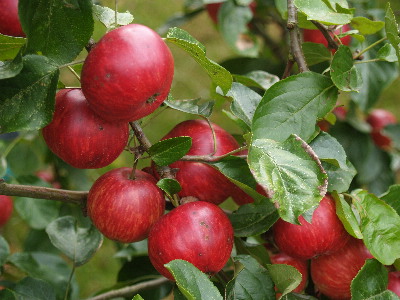 How
Much Apple in my Cider?
How
Much Apple in my Cider?
This sounds like a daft question. Cider is made from apples,
surely? Well yes it is, in part. But over the last 40 years or so
the UK cider industry, like the UK brewing industry, has increasingly
relied on the addition of other fermentable sugar syrups to
substitute for apples (or, in brewing, for malt). Originally
these might have been cane or beet sugar, but nowadays they are
typically glucose syrups prepared from the hydrolysis of maize or wheat
starch, or fructose syrups from the hydrolysis of inulin (a
fructose polysaccharide found in the roots of chicory and Jerusalem
artichoke). These are normal commercial food ingredients and
they're widely used across the food industry wherever cheap bulk sugars
are required. Both in brewing and cidermaking they give lighter
styles of product which are perceived to be more in tune with
commercial needs.
These syrups are perfectly wholesome and they do not have to be
declared on the beer or cider label, since alcoholic drinks above 1.2%
ABV are currently exempt from food ingredient labelling. They
allow the cidermaker to add enough sugar to his juice to take it up to
an SG of around 1.100. After fermentation this gives a strong base
cider of around 12 - 14% ABV, which is then diluted with water to
drinking strength for retail sale. This process is known in the
industry as "chaptalisation" (which is a complete misnomer, but that's
another topic), and as a result of this the final cider may contain
only 30% apple juice equivalent and sometimes significantly
less. This is all
quite legal and permitted by Customs and Excise Notice 162 (though for
Excise Duty purposes the definition of 'cider' was changed in
July 2010 to take account of juice content see HMRC link and explanatory note and revised Notice 162).
Nearly all ciders you'll buy in the supermarket are made this way. They
are in effect not ciders any more but "glucose wines".

Some years ago, the UK Food Standards Agency (FSA) became
interested in this as a part of work to develop methods for the
quantification of the fruit content of juice-based drinks.
I worked on the cider part of the contract and my report was
published in 2004 (FSA News 42 page 14). This work is in the public
domain and so you can buy the report direct from the FSA for £10,
but they have also given me permission to post it here on the
website. You can read the whole document as a PDF by clicking this link (Juice Content
in Ciders and Perries).
What does it all mean? Most of the report is concerned with very
detailed analytical aspects of measuring juice content, interesting for
boffins but perhaps not for the world at large. For the present
discussion, pages 1 - 8 and pages 35 - 41 are the most relevant. These
show that the typical
apple juice content of a UK cider at the time of the survey was just 30%. The rest is
water-diluted fermented sugar syrup. The lowest juice content we
found in our work was just 7% apple juice. It was also interesting to
find that about a quarter of the (draught) ciders at a major Cider
Festival were diluted too. Is this what we'd expect?
I personally believe that full ingredients labelling of all alcoholic
drinks, to include beer, cider, wine and spirits is long overdue.
I don't mind if people want to dilute their products
within the law, but I do believe that the public have a
right to know what they're drinking. I am reassured that many
people including the British Retail Consortium and LACORS (the
over-arching body for UK
Trading Standards Officers) agree with me. LACORS have written "there
are likely to be some consumers who
are being misled because they do not realise the degree of
technological
change which has taken place in relation to the manufacture of
alcoholic drinks which has accelerated over the past 20 years"
and "products produced by more
technological means, i.e. cider produced from a sugar solution
fermented with yeasts and with added apple from concentrate/extract
together with colours and artificial sweeteners to adjust the
appearance and taste, should have a single
conventionally formatted ingredients list." (see FSA Labelling Consultation exercise p 85 onwards).
Back to my Contents page
Last updated 17th August 2010
 How
Much Apple in my Cider?
How
Much Apple in my Cider?
 How
Much Apple in my Cider?
How
Much Apple in my Cider?
